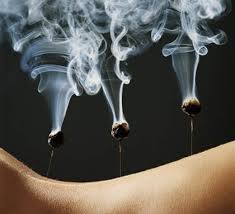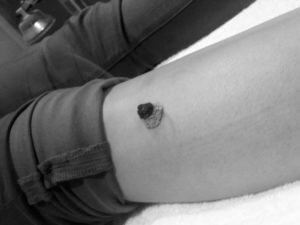What is that SMELL?

I have had more than one client walk into my clinic wondering (and yes I can tell by look on their face they are WONDERING) what that herbal smell is…I resolve this confusion by promptly informing them of a technique commonly used in Traditional Chinese Medicine (TCM) called moxibustion (or moxa for short).
Moxibustion is a technique that involves the burning of mugwort, which is an herb that facilitates healing through warming and penetrating. The purpose of moxibustion is to stimulate the flow of Qi (pronounced “chee”), strengthen the blood and maintain general health. Qi is translated as life energy. There are two types of moxibustion, direct and indirect. Direct moxibustion uses herb shaped into a small cone and is placed on top of an acupuncture point and burned. This type of moxibustion has two subcategories, scarring and non-scarring. Scarring moxa burns until it distinguishes on its own. This may lead to localized scarring and blisters. Non-scarring moxa allows for the herb to be placed on the acupuncture point, lit, extinguished and removed before it burns the skin. This (non-scarring) is the only type of moxa used in our clinic.
Non-scarring moxibustion creates a pleasant heating sensation that penetrates deeply into the skin, but does not create a scar or any pain. Indirect moxibustion is the more popular of the forms. In indirect moxibustion, a practitioner lights one end of a stick of moxa and holds it close to the acupuncture point for several minutes until the area turns red.
Moxibustion is used to help people with cold or stagnant conditions. Burning moxa is believed to expel cold and warm the energetic meridians, which creates the smooth flow of Qi and blood. Moxibustion also supports the yang energy, which strengthens and increases the original Qi. Moxibustion can be used to treat many conditions including back pain, muscle stiffness, headaches, tendonitis, arthritis, digestive disorders, anxiety, menstrual cramps, irregular periods and infertility. It is an extremely effective treatment for turning breech/malpositioned babies in pregnancy. Moxibustion is not recommended for diabetic patients, since they have decreased sensitivity to pain and compromised circulation.
Moxibustion is very effectively used in patients that have a cold constitution. Many chronic conditions, even the ones that manifest as heat conditions, can have chronic cold as the underlying situation. A cold constitution is triggered or aggravated by over cooling the body systems. Because of technological advances, our bodies are exposed to cold at a much higher rate than in the past. Things like living in cold climates, jumping into cold water, refrigeration, air-conditioning, iced beverages and even ice cream have created a society of people with cold constitutions. Also many pharmaceutical drugs including over-the-counter pain medications are known to decrease body temperature. Large consumption of fruits and raw vegetables and ongoing mental and emotional stress can also create cold constitutions. Therefore using moxibustion is frequently warranted in the treatment of many illnesses and diseases.

Moxibustion on acupuncture point Stomach-36
Furthermore, moxibustion on the acupuncture point Stomach 36 (see image) also has the function of preventing diseases and maintaining health. In ancient China, this technique was known as reverse moxibustion. Even if a person is quite healthy, regular moxibustion on this point can invigorate healthy Qi and strengthen the immune system, thus increasing longevity. Perhaps this is why the point has been nicknamed the “longevity point”.
As with acupuncture, only a licensed practitioner should be called upon for treatments such as moxibustion. If you believe that moxibustion may be helpful with your medical conditions, be sure to discuss it with your acupuncturist or contact us for a free phone consult.